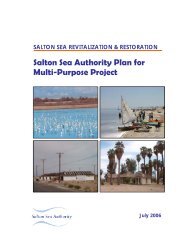Salton Sea Preliminary In-Sea Geotechnical Investigation
Salton Sea Preliminary In-Sea Geotechnical Investigation
Salton Sea Preliminary In-Sea Geotechnical Investigation
Create successful ePaper yourself
Turn your PDF publications into a flip-book with our unique Google optimized e-Paper software.
SECTIONSIX<strong>Preliminary</strong> Embankment Design Considerations"Vibro-compaction" consists of inserting a large vibratory probe into the soil. The “vibro-wing" methodconsists of drilling a metal rod with a number of metal wings affixed to it into the soils with a vibratoryhammer. These techniques have been found to work well on silty sands and clean sands. "Vibroreplacement"is a modification of vibro-compaction in which granular columns (stone columns) are usedto backfill the hole created by the vibratory probe. As discussed above, this method can also be used onfiner-grained material as it provides reinforcement to the soil and drainage for excess pore waterpressures. Vibro-replacement will most likely be required in areas that have high silt and clay contents(greater than about 15 percent fines). The spacing of these techniques is typically 5 to 10 feet.Large diameter (mammoth) sand compaction piling has been used on major overwater developmentsoverseas; particularly to stabilize very soft clays found in north- and south-east Asia. A significant projectsuch as the <strong>Salton</strong> <strong>Sea</strong> Restoration could generate interest from international contractors, where thistechnology has a wide-ranging experience base. Overwater mammoth compaction piles are typically 4 to6 ½ feet in diameter. Two to four piles are driven simultaneously from a large barge.Evaluation of the need and cost-effectiveness of these ground improvement techniques should beundertaken during the revision or development of alternative restoration schemes.6.4 POST-CONSTRUCTION SETTLEMENTS<strong>In</strong>-<strong>Sea</strong> embankments will need to be designed with some freeboard to prevent overtopping by wind- orseismically-driven waves (seiches). The design of in-<strong>Sea</strong> embankments will also need to recognize thepotential for long-term settlement of the embankment due to consolidation of the underlying silts andclays. Excess pore pressures will be generated in these soils when the load of the embankment fills isplaced. Surface settlements will occur as these pore pressures dissipate and the soils consolidate. <strong>In</strong> theclayier materials, this dissipation may take years, and the post-construction settlements may be severalfeet in magnitude. The designs could accommodate these post-construction settlements by initiallyoverbuilding the embankment such that the freeboard is maintained when the consolidation settlementsare complete, or by periodically raising the embankment as the settlements occur.<strong>Preliminary</strong> analyses were performed to evaluate the potential magnitude of consolidation settlements.The results of these analyses are presented in Table 10. These preliminary analyses only considered theprimary consolidation settlements from the seafloor and soft lacustrine deposits. It is anticipated that mostof the consolidation settlements will occur in these deposits due to the large increase in effective stress(relative to existing overburden pressures) and their high compressibilities. These analyses indicate that 4to 6 feet of settlement could occur for an embankment crest at elevation -225 feet MSL, where the softmaterials were deep along the mid-<strong>Sea</strong> alignment (the stratigraphy at CPTs 3 and 29 were used for theanalyses). Four to five feet of settlement are estimated for an embankment crest at elevation -240 feetMSL. These magnitudes would occur beneath the crest of the embankment, less settlement would occurbeneath the slopes of the embankment. It is estimated that the average settlement across the bottom of anembankment (with side slopes at 6:1 and a crest width of 30 feet) would be about 60 to 65 percent of themagnitude at the crest cited above. This value could be used to estimate embankment quantities.As discussed in Section 5.1.3, the rate of consolidation settlements is estimated using an estimated c V ,which typically exhibits large variabilities in laboratory testing. Large earthwork projects oftenincorporate test fills to better estimate settlement magnitudes and rates. Therefore, parametric analysesW:\27663042\00005-c-r.doc\1-Mar-04\SDG 6-3



